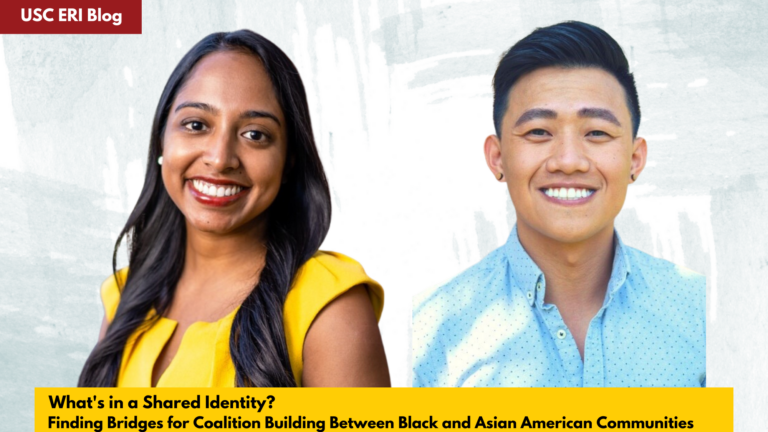
What’s in a Shared Identity?
We are at a time of intense racial strain as Black people continue to be murdered by state-sanctioned violence, Asian American communities are experiencing increasing incidents of hate, and generations of multiracial solidarity are tested. There is a burdening sense of hopelessness and anger, especially as we see how minoritized communities are deliberately used as pawns in political decisions and put in opposition to each other in the media and in policy discussions.
We see in our daily lives how white supremacy capitalizes on and feeds the growing tensions between Black and Asian communities during a time of heightened fears and growing inequality, upholding its power through policies and policing. Politicians perpetually exacerbate racial tensions through controversial and unjust policies purporting a false zero-sum narrative, as recently as Ron DeSantis’s mandate to require Asian American Pacific Islander history in K-12 curriculum while banning teachings of critical race theory, barring AP African American Studies in Florida public schools, and defunding diversity, equity, and inclusion efforts in public colleges. Such political tactics have historically used Asian Americans and their selective proximity to whiteness to denigrate Black communities and erase their struggles.
In processing these events and how they diminish collective power by challenging coalition building between two minoritized groups, we turn to our own experiences and communities’ histories to make sense of these interracial dynamics, and to share a more hopeful narrative for continued solidarity and fight for racial justice. As a mixed-race South Asian and Black woman and an Asian American man, our conversations revisited how public media and social discourse have historically and continuously pitted people who look like us against each other to prop up established social orders. We have witnessed, experienced, and recognized that anti-Blackness in Asian American communities and anti-Asian hate in Black communities are prevalent and have real consequences for opportunity structures. As we continue our endeavors for racial justice and solidarity, however, we must remind ourselves of an important but overlooked piece to this story: generations of Black and Asian American power and coalition building have overcome struggles through a shared understanding that our pathways to justice are tied to each other’s liberation.
How Existing Racial Dynamics are Rooted in Our History
In the United States, the racialization of Asian Americans and Black Americans has been historically complex and intertwined. Foundational histories of African enslavement and Asian American incarceration serve as core examples of the ongoing denigration of African Americans as inferior and Asian Americans as outsiders, fostering tensions between Black and Asian American communities while upholding white superiority. This Black-Asian racial tension and racial resentment have manifested in many ways throughout history. For example, the model minority myth, which essentializes Asian Americans as prosperous, obedient, and successful minorities despite societal challenges, has been used as a racial wedge against other minoritized groups, especially Black Americans, to argue that racism can be overcome by “pulling yourself up by your bootstraps.”
Black-Asian racial tensions are not insulated nor inconsequential. We see how minoritized communities are set up for conflict in dynamics like the Black-Korean conflict assumed to have contributed to the 1992 Los Angeles riots and uprising whereby Korean Americans were deemed the “middleman minority group” in the predominantly Black and economically excluded area of South Central Los Angeles. More recently, Asian Americans have been falsely portrayed as major opponents of affirmative action and Black Americans have been discriminately positioned as perpetrators of growing anti-Asian violence during the COVID-19 pandemic.
Though stories about tensions, violence, and conflicting interests between Black and Asian communities have created salacious headlines for mainstream media outlets and conservative activists seeking scapegoats to uphold white supremacy, there is a deep, long-standing history of coalition building, solidarity, and collective advocacy among these groups that is overlooked despite its impact. Leaders of racial justice movements, such as Malcolm X, Ida B. Wells, Yuri Kochiyama, and Grace Lee Boggs, have advocated explicitly for the needs of communities beyond their own. Whether it is the Black-Korean Alliance in the wake of the 1992 LA uprising, the role of the Civil Rights Movement in expanding immigration from Asia, or the Third World Liberation Front (TWLF) that catalyzed Ethnic Studies in the United States, Black and Asian coalition building under a shared identity of marginalization has worked to fight white supremacy, inequality, and injustice.
Exploring the Value of a Shared Social Identity
As conversations persist on racially-contentious topics, including whether Asian Americans are the next in line to become white, how anti-Black rhetoric amongst Latinx, LA city council members fostered distrust, and the ways ethnic studies curriculum further develop and are challenged, how can we ensure that the rich history of coalition building across minoritized communities are not overlooked but act as a foundation for solidarity? One piece to this strategy will undoubtedly need to focus on the spaces and the people tasked with supporting the next generation of young leaders: high school classroom teachers. In our research on high school classroom teachers in Los Angeles, we begin to explore whether the term “People of Color (POC)” is still relevant in facilitating a shared identity around a history of struggle and resilience.
With grant support from the American Educational Research Association’s (AERA) Division G: Social Context of Education organization and in collaboration with the Partnership for Los Angeles Schools, we shared a survey with The Partnership’s educator community. What we found in a pilot survey study among 67 high school classroom teachers was that the term POC is least likely to be associated with Asian Americans among non-White racial/ethnic identities, whereas African, African American, and Black groups were most likely to be identified as POC. Interestingly, we found that Black respondents were the least likely to identify people who are African, African American, and Black as People of Color. However, this is likely skewed because of the small pilot sample (i.e., 4 out of 6 respondents report African, African American, and Black people as People of Color). This data point may be nuanced by how participants view the relevance of the term “People of Color.” For example, one Black participant stated that they preferred to use the term “non-white” as they believed that “POC” felt “reductive and [created] a shared experience that is mythical.”
Following this pilot study, more questions arose about the pathways to coalition building through a shared identity. We were left wondering: Is the term “People of Color” still an effective marker of the potential for coalition building among the marginalized or has it become passé with this next generation of educators and learners? What is driving skepticism about the term “People of Color” among some and is it warranted?
As we have seen in the past with coalition building, shared identity labels like “racial minorities,” “non-white,” and “People of Color” were used to bring together communities that have been oppressed, marginalized, and ostracized by white supremacy. These shared identities have been strategically used to unite communities of color, however, misusing such shared identity labels can also create harm when they do not recognize the unique lived experiences, particularities, and nuanced racialization of specific racial/ethnic groups. In using these shared identity markers, we must also be cognizant that there have been intragroup tensions within communities of color, especially when fighting for crumbs in what is served to us as a zero-sum game. However, we know from our histories that one community’s gain is not another’s loss when we come together informed by our collectivist traditions to develop a shared vision for justice.
Regardless of the term used to unite across shared struggles, it is imperative that our communities learn each other’s history to find common threads that will strengthen the foundations for coalition building. Even though we may be left with more questions than we first endeavored in this project, we continue to see the importance of having these conversations in our classrooms and across our communities.
About the authors:

Dr. Liane I. Hypolite (she/her) is an Assistant Professor of Educational Leadership at California State Polytechnic University, Pomona where she teaches educational leaders who work across K12 and higher education settings. Dr. Hypolite conducts equity-driven research focused on analyzing the complex ways that institutional racism influences educational systems. Her research studies explore the ways that students, educators, and community members find opportunities for success and well-being, despite navigating unjust systems.
Dr. Thai V. Le (he/him) is the Turpanjian Postdoctoral Fellow in Civil Society and Social Change at the USC Equity Research Institute. Dr. Le is a mixed-methods researcher studying varying topics of social equity, including immigrant inclusion, the digital divide, racialized and gendered burnout experiences in public organizations, the role of cultural competency on public service, diversity management, and representative bureaucracy. Dr. Le’s research focuses on the mechanisms that drive inequality and how policy and programmatic interventions can address such disparities.
© 2023. This work is licensed under a CC BY-NC-ND 4.0 license.